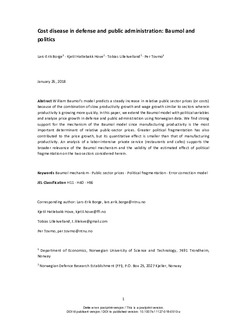| dc.contributor.author | Borge, Lars-Erik | |
| dc.contributor.author | Hove, Kjetil Hatlebakk | |
| dc.contributor.author | Lillekvelland, Tobias | |
| dc.contributor.author | Tovmo, Per | |
| dc.date.accessioned | 2018-08-09T15:39:50Z | |
| dc.date.available | 2018-08-09T15:39:50Z | |
| dc.date.created | 2018-06-01T10:58:01Z | |
| dc.date.issued | 2018 | |
| dc.identifier.citation | Public Choice. 2018, 175 (1-2), 1-18. | nb_NO |
| dc.identifier.issn | 0048-5829 | |
| dc.identifier.uri | http://hdl.handle.net/11250/2508296 | |
| dc.description.abstract | William Baumol’s model predicts a steady increase in relative public sector prices (or costs) because of the combination of slow productivity growth and wage growth similar to sectors wherein productivity is growing more quickly. In this paper, we extend the Baumol model with political variables and analyze price growth in defense and public administration using Norwegian data. We find strong support for the mechanism of the Baumol model since manufacturing productivity is the most important determinant of relative public-sector prices. Greater political fragmentation has also contributed to the price growth, but its quantitative effect is smaller than that of manufacturing productivity. An analysis of a labor-intensive private service (restaurants and cafes) supports the broader relevance of the Baumol mechanism and the validity of the estimated effect of political fragmentation on the two sectors considered herein. | nb_NO |
| dc.language.iso | eng | nb_NO |
| dc.publisher | Springer Verlag | nb_NO |
| dc.title | Cost disease in defense and public administration: Baumol and politics | nb_NO |
| dc.type | Journal article | nb_NO |
| dc.type | Peer reviewed | nb_NO |
| dc.description.version | acceptedVersion | nb_NO |
| dc.source.pagenumber | 1-18 | nb_NO |
| dc.source.volume | 175 | nb_NO |
| dc.source.journal | Public Choice | nb_NO |
| dc.source.issue | 1-2 | nb_NO |
| dc.identifier.doi | 10.1007/s11127-018-0510-z | |
| dc.identifier.cristin | 1588284 | |
| dc.description.localcode | This is a post-peer-review, pre-copyedit version of an article published in [Public Choice] Locked until 3.2.2019 due to copyright restrictions. The final authenticated version is available online at: https://doi.org/10.1007/s11127-018-0510-z | nb_NO |
| cristin.unitcode | 194,60,20,0 | |
| cristin.unitname | Institutt for samfunnsøkonomi | |
| cristin.ispublished | true | |
| cristin.fulltext | postprint | |
| cristin.qualitycode | 1 | |
